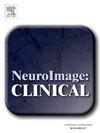Altered cerebellar activation patterns in Alzheimer’s disease: An activation likelihood estimation Meta-Analysis
IF 3.6
2区 医学
Q2 NEUROIMAGING
引用次数: 0
Abstract
The past decade has seen an increased interest in the cerebellum, particularly in non-motor behaviors. Emerging work across model systems and in humans has also implicated the cerebellum in Alzheimer’s Disease (AD) and in mild cognitive impairment (MCI). While the cerebellum is not seen as being central to the etiology of the disease, it is however recognized as being increasingly important, and most certainly not immune from disease-related pathology and atrophy. In cognitively normal older adults (OA), the cerebellum has been conceptualized as being critical scaffolding for cortical function. This scaffolding may extend to AD and MCI. With respect to functional imaging, this is largely unexplored in AD, as this is a nascent literature. While there are very few studies focused on the cerebellum in AD at this stage, meta-analysis provides a powerful tool for expanding our knowledge of the cerebellum in neurodegenerative disease, and, in turn, for hypothesis generation. We took advantage of activation likelihood estimation (ALE) meta-analysis to investigate overlap in functional activation present in the existing literature. We focused on AD, but also included an exploratory analysis of MCI, based on papers available in our AD search. Our analysis included a total of 29 studies, representing data from 236 individuals with AD, 159 with MCI, and 382 OA. Across these studies, there is no significant overlap in cerebellar activation in AD, though this is present in MCI. Analyses of group differences also suggest that across studies, there are patterns indicative of both greater and reduced activation in AD/MCI relative to OA. Across all findings, overlap was primarily centered on Crus I and Lobule VI. These findings suggest that cerebellar function is negatively impacted in AD, which in turn may impact behavior and symptomatology.
阿尔茨海默病小脑激活模式改变:激活可能性估计meta分析
在过去的十年中,人们对小脑的兴趣与日俱增,尤其是在非运动行为方面。新近在模型系统和人体中开展的研究也表明,小脑与阿尔茨海默病(AD)和轻度认知障碍(MCI)有关。虽然小脑并不被认为是疾病病因的核心,但人们认识到它越来越重要,而且肯定不会幸免于与疾病相关的病理变化和萎缩。在认知能力正常的老年人(OA)中,小脑被认为是大脑皮层功能的重要支架。这种支架作用可能会延伸到老年痴呆症和 MCI。在功能成像方面,由于相关文献尚处于起步阶段,对注意力缺失症的研究在很大程度上还处于空白。虽然现阶段针对AD小脑的研究很少,但荟萃分析为我们提供了一个强大的工具,可以扩展我们对神经退行性疾病中小脑的认识,进而提出假设。我们利用激活似然估计(ALE)荟萃分析来研究现有文献中存在的功能激活重叠。我们的重点是注意力缺失症,但也根据注意力缺失症检索中的论文对 MCI 进行了探索性分析。我们的分析共包括 29 项研究,代表了 236 名 AD 患者、159 名 MCI 患者和 382 名 OA 患者的数据。在这些研究中,AD 患者的小脑激活没有明显重叠,但 MCI 患者的小脑激活存在重叠。对组间差异的分析还表明,在所有研究中,AD/MCI患者的小脑激活既有相对于OA患者更强的模式,也有相对于OA患者更弱的模式。在所有研究结果中,重叠主要集中在Ⅰ区和Ⅵ区。这些研究结果表明,注意力缺失症患者的小脑功能受到负面影响,进而可能影响行为和症状。
本文章由计算机程序翻译,如有差异,请以英文原文为准。
求助全文
约1分钟内获得全文
求助全文
来源期刊

Neuroimage-Clinical
NEUROIMAGING-
CiteScore
7.50
自引率
4.80%
发文量
368
审稿时长
52 days
期刊介绍:
NeuroImage: Clinical, a journal of diseases, disorders and syndromes involving the Nervous System, provides a vehicle for communicating important advances in the study of abnormal structure-function relationships of the human nervous system based on imaging.
The focus of NeuroImage: Clinical is on defining changes to the brain associated with primary neurologic and psychiatric diseases and disorders of the nervous system as well as behavioral syndromes and developmental conditions. The main criterion for judging papers is the extent of scientific advancement in the understanding of the pathophysiologic mechanisms of diseases and disorders, in identification of functional models that link clinical signs and symptoms with brain function and in the creation of image based tools applicable to a broad range of clinical needs including diagnosis, monitoring and tracking of illness, predicting therapeutic response and development of new treatments. Papers dealing with structure and function in animal models will also be considered if they reveal mechanisms that can be readily translated to human conditions.
 求助内容:
求助内容: 应助结果提醒方式:
应助结果提醒方式:


